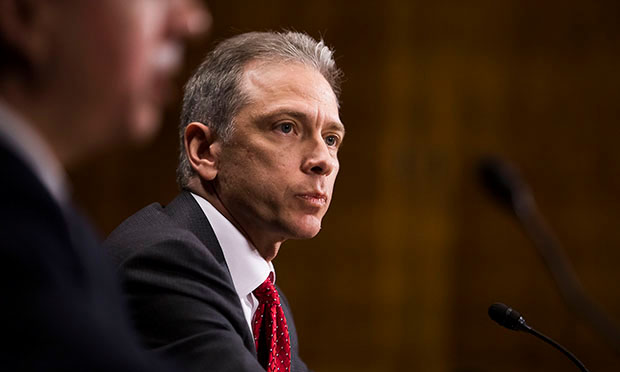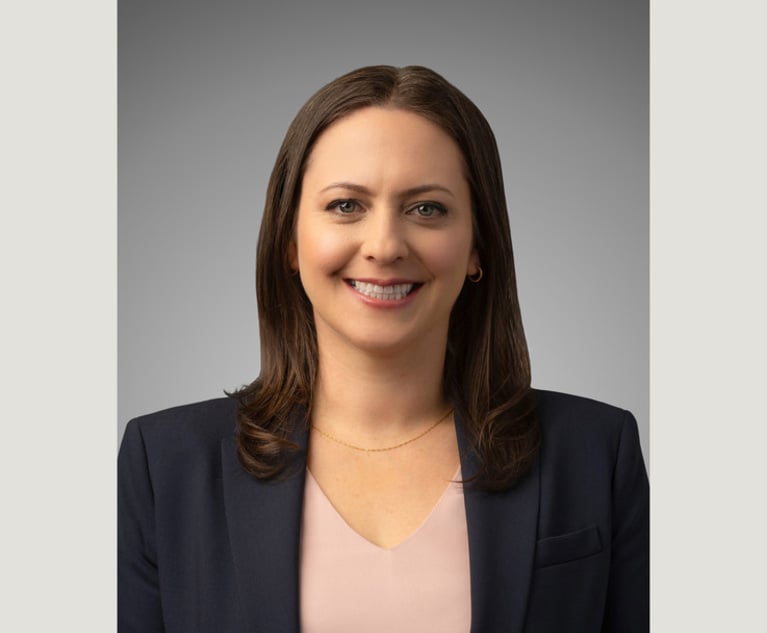PTO Gives Iancu More Control Over PTAB Precedents
The agency is aiming to create more precedential opinions while steering away from the practice of "stacking" its judicial panels.
September 21, 2018 at 04:07 PM
3 minute read
 Andrei Iancu testifies during his confirmation hearing before the Senate Judiciary Committee to be under secretary of commerce for intellectual property and director of the U.S. Patent and Trademark Office on Nov. 29, 2017. Photo: Diego M. Radzinschi/ALM
Andrei Iancu testifies during his confirmation hearing before the Senate Judiciary Committee to be under secretary of commerce for intellectual property and director of the U.S. Patent and Trademark Office on Nov. 29, 2017. Photo: Diego M. Radzinschi/ALM
In case there was any doubt, USPTO Director Andrei Iancu is in charge at the Patent Trial and Appeal Board.
The U.S. Patent and Trademark Office announced revisions to PTAB procedures Thursday that formalize Iancu's control over the 250 administrative patent judges and their policy-making, while making that control more transparent.
“The revisions focus upon increasing transparency, predictability, and reliability across the USPTO,” the agency said in its announcement.
The primary change is the creation of a sort of PTAB appellate panel comprising Iancu, Commissioner of Patents Drew Hirshfeld, and the PTAB's chief judge, a position that's currently vacant. Those three or their designees will have the authority to make PTAB panel decisions precedential, or to reconsider panel decisions and issue their own precedential opinions.
Scott McKeown, the chairman of Ropes & Gray's PTAB group, said the Precedential Opinion Panel solves several problems. One is that the PTAB wasn't issuing enough precedent to help practitioners. The previous rules for designating a precedential opinion, which required a majority vote of the board, was drawn up when the PTAB numbered 30 or 40 administrative judges. Now at 250 judges thanks to the America Invents Act, the board could find agreement on only about five precedential opinions a year.
Second is that the strategy the board used to get around that problem—expanding the panels in important cases by adding judges from PTAB leadership—was highly unpopular. While McKeown thinks the criticisms were somewhat overblown, “the board recognized a while back that just looks bad.”
Finally, the new procedures will defuse another nascent criticism: that PTAB judges are constitutional officers under the Supreme Court's Lucia v. SEC decision who should be subject to Senate conformation. The new procedures “make it clear the political appointee is running the show, because that's the way it's supposed to work. That's the way other agencies work,” McKeown said. He cited the International Trade Commission, which reviews its ALJs' decisions, as an example.
Along with the Precedential Opinion Panel, the PTAB also issued detailed new procedures that spell out how judges are assigned or reassigned to cases, while making clear that “an expanded panel is not favored and ordinarily will not be used.”
William Atkins, a Pillsbury Winthrop Shaw Pittman partner and author of “The PTAB Handbook,” said he's “grateful to see panel stacking going by the wayside.” He said it was unsettling to have additional judges appear in a case without prior notice. “Now there's a policy and an explanation,” he said.
And the decisions will come from “a consistent, core group of people,” Baker Botts partner Eliot Williams said.
Williams said it's probably too early to assess the Precedential Opinion Panel. For one thing, it's not clear yet how often it intends to weigh in. “Overall,” he said, “I think everyone should be happy to see the transparency in how the board is going to operate on these issues.”
This content has been archived. It is available through our partners, LexisNexis® and Bloomberg Law.
To view this content, please continue to their sites.
Not a Lexis Subscriber?
Subscribe Now
Not a Bloomberg Law Subscriber?
Subscribe Now
NOT FOR REPRINT
© 2025 ALM Global, LLC, All Rights Reserved. Request academic re-use from www.copyright.com. All other uses, submit a request to [email protected]. For more information visit Asset & Logo Licensing.
You Might Like
View All
Weil Lures DOJ Antitrust Lawyer, As Government Lateral Moves Pick Up Before Inauguration Day
5 minute read
Supreme Court Wrestles With Disabled Ex-Firefighter's Discrimination Case

SEC Ordered to Explain ‘How and When the Federal Securities Laws Apply to Digital Assets’
5 minute read
Kirkland, Cleary, King & Spalding Among the Latest to Add DC Laterals
3 minute readTrending Stories
Who Got The Work
J. Brugh Lower of Gibbons has entered an appearance for industrial equipment supplier Devco Corporation in a pending trademark infringement lawsuit. The suit, accusing the defendant of selling knock-off Graco products, was filed Dec. 18 in New Jersey District Court by Rivkin Radler on behalf of Graco Inc. and Graco Minnesota. The case, assigned to U.S. District Judge Zahid N. Quraishi, is 3:24-cv-11294, Graco Inc. et al v. Devco Corporation.
Who Got The Work
Rebecca Maller-Stein and Kent A. Yalowitz of Arnold & Porter Kaye Scholer have entered their appearances for Hanaco Venture Capital and its executives, Lior Prosor and David Frankel, in a pending securities lawsuit. The action, filed on Dec. 24 in New York Southern District Court by Zell, Aron & Co. on behalf of Goldeneye Advisors, accuses the defendants of negligently and fraudulently managing the plaintiff's $1 million investment. The case, assigned to U.S. District Judge Vernon S. Broderick, is 1:24-cv-09918, Goldeneye Advisors, LLC v. Hanaco Venture Capital, Ltd. et al.
Who Got The Work
Attorneys from A&O Shearman has stepped in as defense counsel for Toronto-Dominion Bank and other defendants in a pending securities class action. The suit, filed Dec. 11 in New York Southern District Court by Bleichmar Fonti & Auld, accuses the defendants of concealing the bank's 'pervasive' deficiencies in regards to its compliance with the Bank Secrecy Act and the quality of its anti-money laundering controls. The case, assigned to U.S. District Judge Arun Subramanian, is 1:24-cv-09445, Gonzalez v. The Toronto-Dominion Bank et al.
Who Got The Work
Crown Castle International, a Pennsylvania company providing shared communications infrastructure, has turned to Luke D. Wolf of Gordon Rees Scully Mansukhani to fend off a pending breach-of-contract lawsuit. The court action, filed Nov. 25 in Michigan Eastern District Court by Hooper Hathaway PC on behalf of The Town Residences LLC, accuses Crown Castle of failing to transfer approximately $30,000 in utility payments from T-Mobile in breach of a roof-top lease and assignment agreement. The case, assigned to U.S. District Judge Susan K. Declercq, is 2:24-cv-13131, The Town Residences LLC v. T-Mobile US, Inc. et al.
Who Got The Work
Wilfred P. Coronato and Daniel M. Schwartz of McCarter & English have stepped in as defense counsel to Electrolux Home Products Inc. in a pending product liability lawsuit. The court action, filed Nov. 26 in New York Eastern District Court by Poulos Lopiccolo PC and Nagel Rice LLP on behalf of David Stern, alleges that the defendant's refrigerators’ drawers and shelving repeatedly break and fall apart within months after purchase. The case, assigned to U.S. District Judge Joan M. Azrack, is 2:24-cv-08204, Stern v. Electrolux Home Products, Inc.
Featured Firms
Law Offices of Gary Martin Hays & Associates, P.C.
(470) 294-1674
Law Offices of Mark E. Salomone
(857) 444-6468
Smith & Hassler
(713) 739-1250










